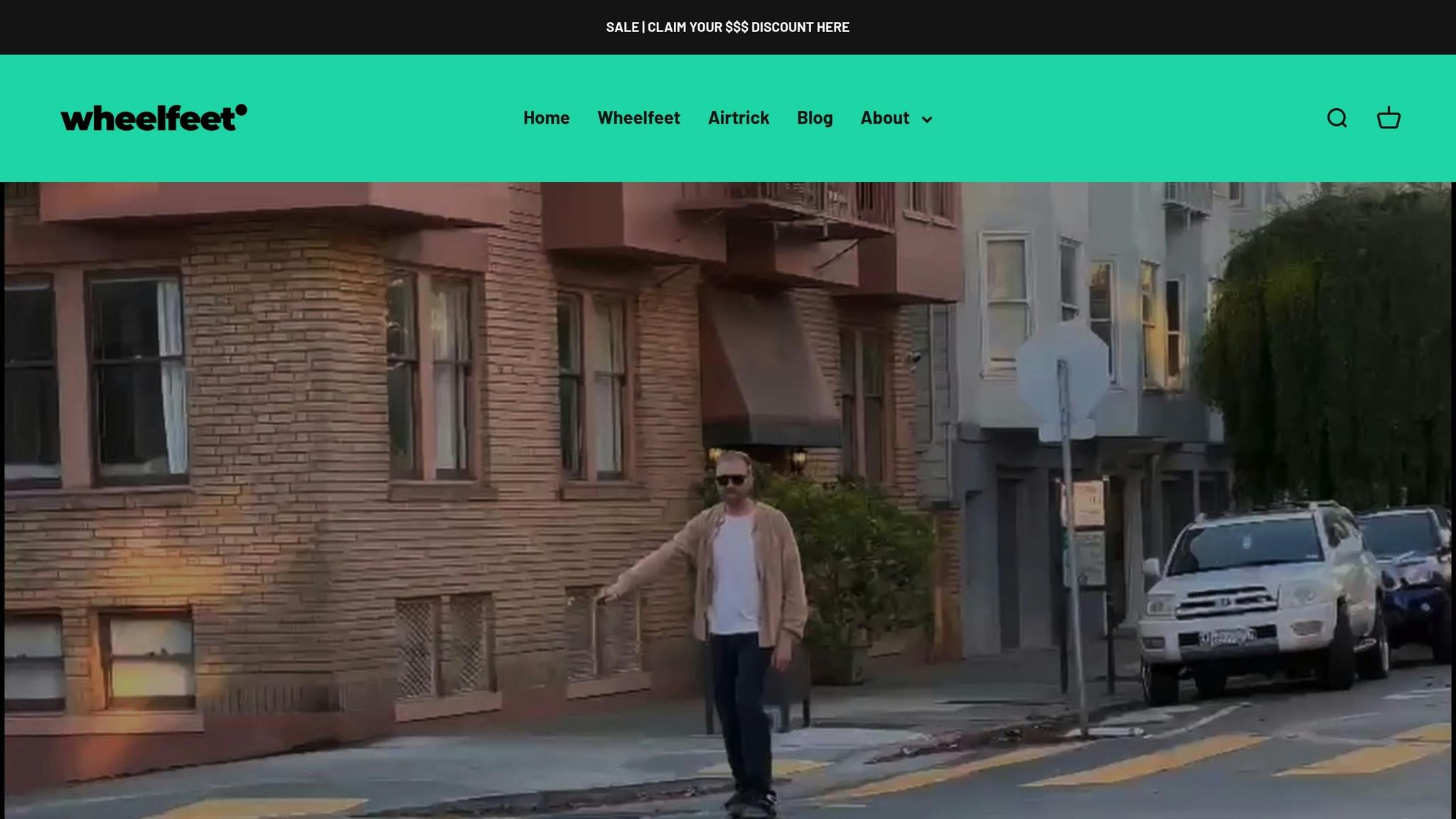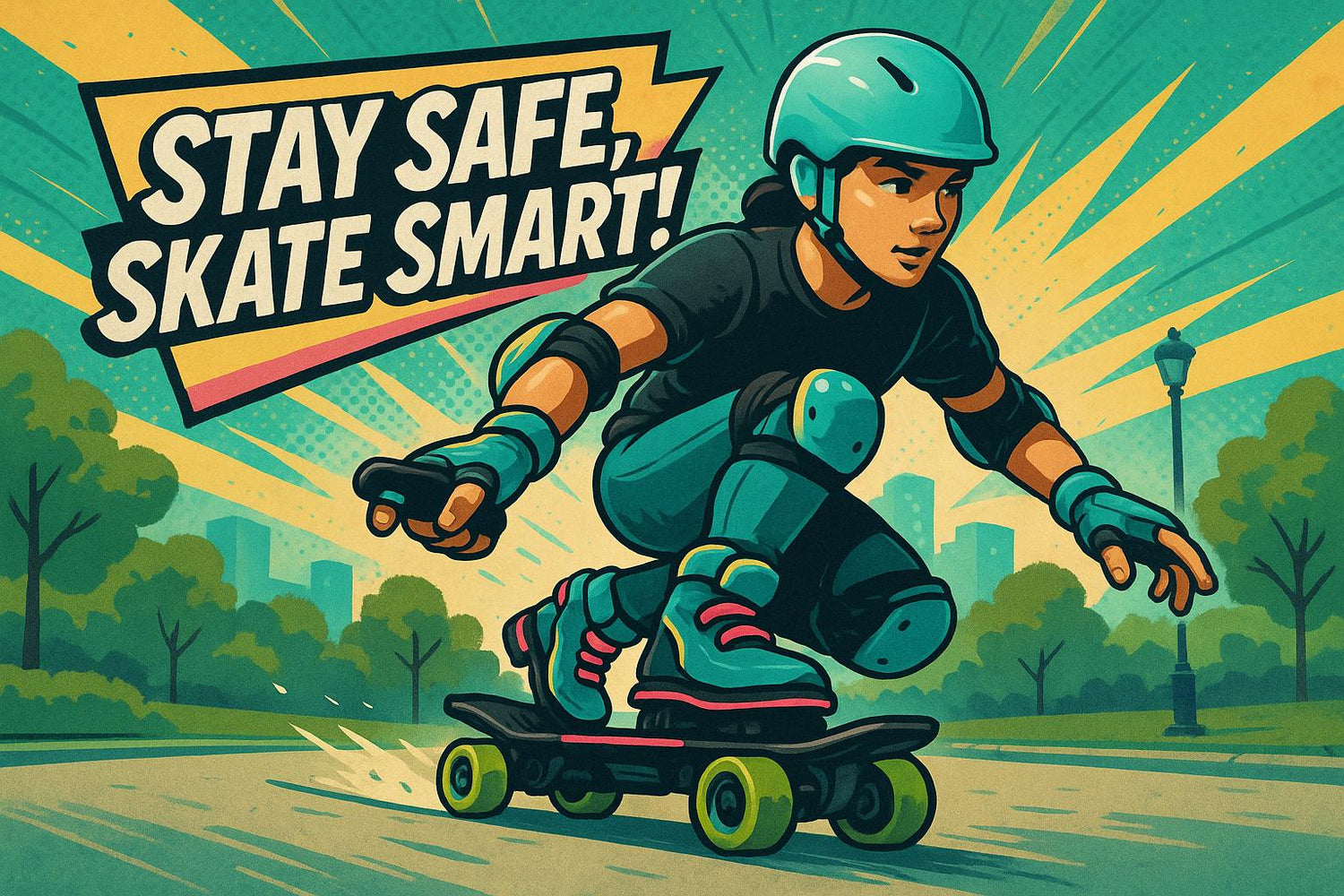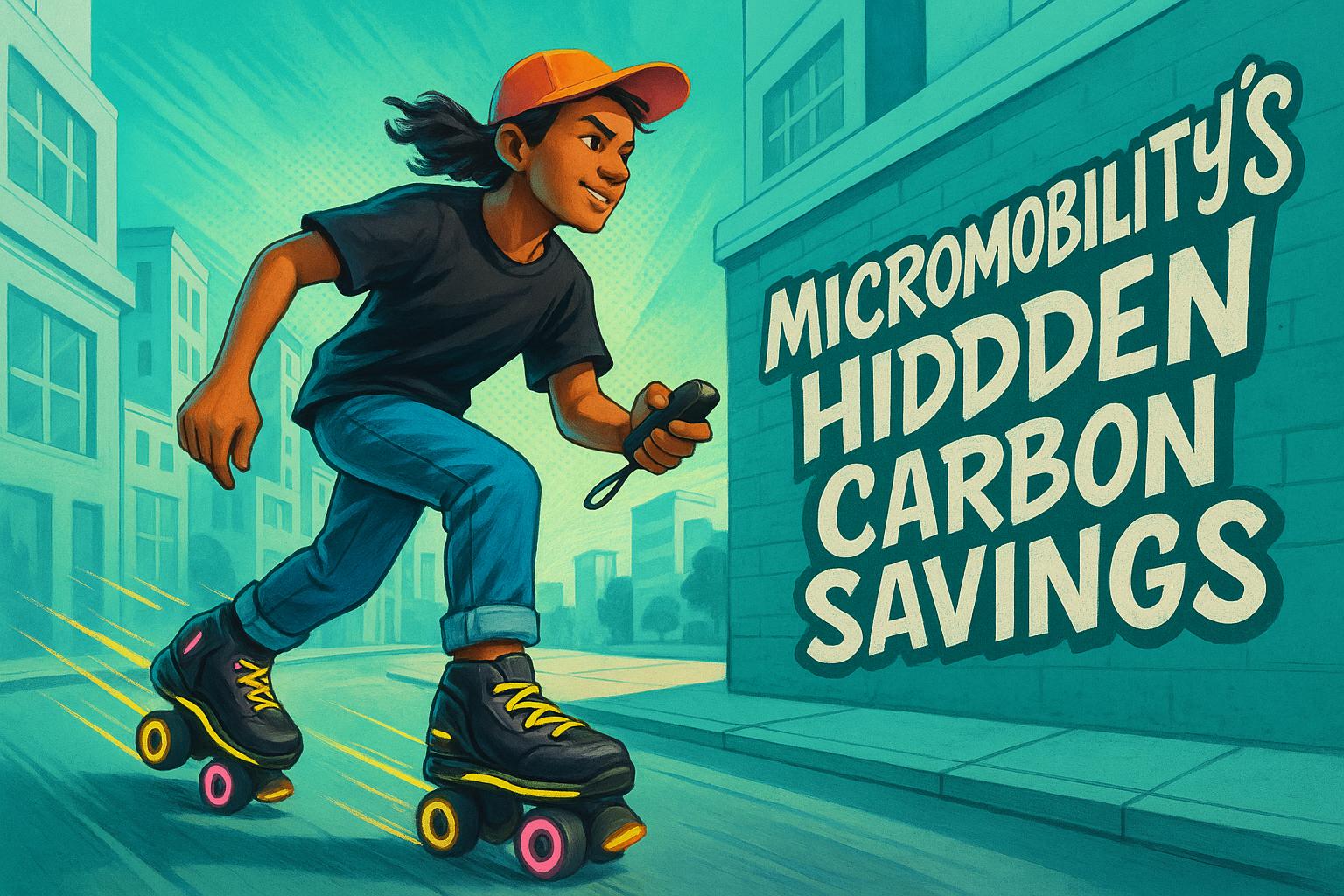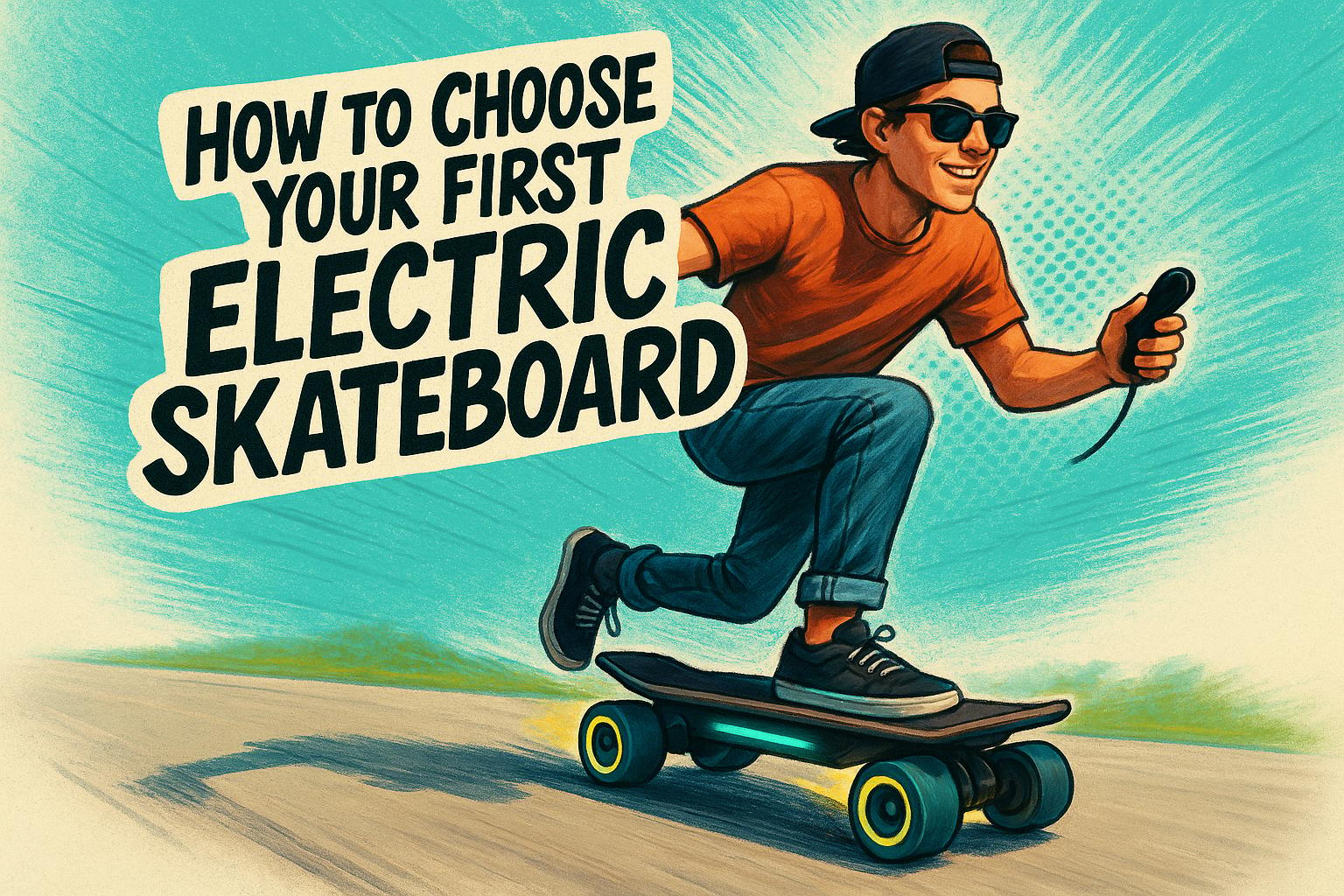Electric roller skating is thrilling, but safety should always come first. Whether you're cruising at speeds up to 15 mph or navigating busy streets, proper safety gear is non-negotiable. Here's what you need to stay protected and confident on your Wheelfeet e-skates:
- Helmet: Protects your head from serious injuries. Look for a snug fit, proper certifications (like CPSC), and features like ventilation and MIPS technology for added safety.
- Knee and Elbow Pads: Shields your joints from impact and abrasions. Choose pads with hard plastic caps, thick foam padding, and adjustable straps for comfort and security.
- Wrist Guards: Prevents wrist injuries during falls. Opt for guards with rigid splints, breathable materials, and a secure fit.
- Reflective Gear: Enhances visibility in low-light conditions. Consider reflective clothing, adhesive tape, and LED accessories to ensure you're seen by others.
- Gear Maintenance: Regularly clean and inspect your gear to keep it effective. Replace worn-out items, especially reflective gear, to maintain protection and visibility.
Investing in the right safety equipment not only reduces the risk of injuries but also allows you to enjoy your rides with peace of mind. Stay safe, stay visible, and make every ride a great one.
Helmet Selection for E-Skating
Why You Need a Helmet
When you're gliding around on Wheelfeet electric roller skates, your head is one of the most vulnerable parts of your body. Even a seemingly minor fall can lead to serious injuries if you hit a hard surface like concrete or asphalt. That’s why wearing a helmet is so important - it’s your first line of defense. A good helmet is designed to absorb and distribute impact forces, reducing the risk of concussions, skull fractures, or worse.
Beyond protection, wearing a helmet sets a great example for others and promotes responsible riding. Plus, in many places, helmet laws for electric mobility devices are becoming more common. Making it a habit now means you’ll be ready for any new regulations down the road.
How to Pick the Right Helmet
Getting the right fit is key when choosing a helmet for your Wheelfeet adventures. Start by measuring your head circumference about an inch above your eyebrows using a flexible measuring tape. A helmet that’s too loose might shift during a fall, while one that’s too tight will be uncomfortable and distracting.
The helmet should sit level on your head, covering your forehead without tilting backward. When you shake your head from side to side, it should move as one unit with you. Make sure the chin strap is snug and secure - it’s what keeps the helmet in place when it matters most.
Always look for helmets that meet CPSC (Consumer Product Safety Commission) certification standards. This ensures the helmet has passed rigorous testing for impact resistance and retention. Some helmets may also carry additional certifications like ASTM or EN standards, offering even more peace of mind.
Don’t overlook ventilation, especially if you’re planning longer rides or skating in warmer weather. Helmets with well-placed vents allow for better airflow without sacrificing protection. Many models also feature adjustable systems, like dial-fit mechanisms, to fine-tune the fit - perfect for accommodating different hairstyles or thin caps.
Once you’ve nailed down the fit and safety features, it’s time to explore the types of helmets that work best for e-skating.
Best Helmet Types for E-Skating
Choosing the right helmet style can make a big difference in both safety and comfort during your rides.
- Multi-sport helmets: Originally designed for activities like skateboarding and cycling, these helmets are a solid choice for electric roller skating. They often provide extended coverage around the back of your head, offering better protection than standard bike helmets.
- Urban commuter helmets: If you’re looking for something sleek and practical, commuter helmets are a great option. They’re perfect for transitioning from your ride to daily activities. Look for features like integrated LED lights for better visibility and extras like magnetic buckles or removable visors for added convenience.
- MIPS-equipped helmets: For those who want extra protection, helmets with MIPS (Multi-directional Impact Protection System) technology are worth considering. MIPS adds a low-friction layer that allows the helmet to move slightly during angled impacts, potentially reducing rotational forces and the risk of severe injury.
No matter your budget, there are helmets that meet safety standards while offering a good balance of protection and affordability. If hygiene is a concern, consider helmets with removable and washable padding to keep things fresh and comfortable over time.
Knee and Elbow Pad Protection
How Knee and Elbow Pads Help
Just like helmets protect your head, properly fitting knee and elbow pads safeguard your joints, completing your safety gear. When you're riding Wheelfeet electric roller skates, your knees and elbows are especially at risk. These joints stick out, making them the first to hit the ground in a fall. Knee and elbow pads act as a shield between your skin and hard surfaces. Most are built with rigid outer shells that spread the force of an impact over a larger area, while the padding inside absorbs shocks to reduce the chance of injury.
The faster you skate, the more critical this protection becomes. At high speeds, even a small tumble can lead to serious issues like road rash, deep cuts, or bruises that could sideline you for weeks. Beyond surface injuries, pads also help protect the delicate structures inside your joints. A direct hit can harm cartilage, tendons, or even cause fractures. In short, these pads don’t just prevent scrapes; they also help preserve the long-term health of your knees and elbows.
What to Look for in Pads
Choosing the right pads is about balancing protection and comfort. Here are the key features to consider:
- Hard plastic caps: Look for durable outer shells that deflect and distribute impact forces, keeping your joints safe.
- Thick foam padding: Materials like EVA foam are great for absorbing shocks. The foam should hold its shape over time while being soft enough for comfort on long rides.
- Adjustable Velcro straps: Multiple straps - typically above and below the joint - help secure the pad in place without cutting into your skin. Velcro is durable and holds up well after repeated use and washing.
- Ventilation: Pads with mesh panels or perforated foam allow air to circulate, keeping you cooler during warm weather or extended rides.
- Low-profile design: A slimmer pad offers better mobility, while thicker pads provide more protection. For electric roller skating, finding a balance between protection and freedom of movement is ideal.
Getting the Right Size and Fit
Once you’ve picked pads with the right features, sizing them correctly is crucial for effective protection. Use a flexible tape measure to get precise measurements:
- For knee pads, measure around the center of your kneecap with your leg slightly bent.
- For elbow pads, measure around the widest part of your elbow while your arm is bent at a 90-degree angle.
Most brands, like Triple 8, offer detailed sizing charts to guide you. Here’s an example:
| Knee Pads | Size | Measurement |
|---|---|---|
| Junior | JR | 11"-12.5" |
| Small | S | 12.5"-14.5" |
| Medium | M | 14.5"-16" |
| Large | L | 16"-17" |
| Extra Large | XL | 17"-19.5" |
| Elbow Pads | Size | Measurement |
|---|---|---|
| Junior | JR | 5"-6" |
| Small | S | 6"-8" |
| Medium | M | 8"-10" |
| Large | L | 10"-12" |
| Extra Large | XL | 12"-14" |
If your measurement falls between sizes, it’s best to size up. As Triple 8 advises:
"If your measurements are in-between the sizes shown or you're simply in doubt, we strongly recommend sizing up to the larger size. We have found over the years that customers do better when they choose the larger size."
Pads that are too tight can restrict movement, affect circulation, and may even shift out of place during a fall. Once you’ve chosen your size, test the fit by moving your joints through their full range of motion. The pads should stay securely in place without sliding or causing discomfort. A proper fit ensures you’re both protected and comfortable while skating.
Just like pads protect your knees and elbows, wrist guards are essential for keeping your hands safe.
Wrist Guards and Hand Protection
Why Wrist Guards Matter
When you fall, your first instinct is often to put your hands out to break the impact. While it might seem natural, this reaction can put a lot of strain on your wrists. A good wrist guard helps maintain proper alignment, limits excessive bending, and reduces the risk of injury. Plus, knowing your wrists are protected can give you added confidence.
What Makes Good Wrist Guards
The best wrist guards combine several important features to offer both protection and comfort:
- Rigid Splints: Look for guards with sturdy plastic or metal splints that provide solid support. These splints should be positioned to align with your palm and wrist, preventing overextension and reducing the chance of injury.
- Breathable Materials: Guards made with moisture-wicking fabrics and perforated padding can keep your hands cool and dry, even during longer sessions.
- Adjustable Closures: Multiple Velcro straps allow you to customize the fit for your hand and wrist. A secure fit ensures the guard stays in place when you need it most.
- Splint Alignment: Make sure the internal plates are centered on your palm and wrist. Misaligned splints can compromise protection and reduce effectiveness.
- Strap Security: Velcro straps should fasten securely without feeling strained. If the straps don’t close properly, the guard might be too small - consider sizing up for better safety.
- Proper Sizing: Measure your wrist or the widest part of your hand (excluding the thumb) and refer to the manufacturer's sizing chart for the best fit.
A well-fitted wrist guard offers the right balance of support for your wrist joint while still allowing your fingers and thumb to move freely. It should feel snug but not restrictive, giving you both protection and comfort.
Reflective Gear for Better Visibility
Why You Need to Stay Visible
Helmets and pads protect you during an impact, but reflective gear plays a different role - it helps prevent incidents by making sure you're seen in the first place. In urban areas, low-light conditions can quickly turn a simple ride into a risky situation. Whether it's cars, pedestrians, or other cyclists, everyone needs to notice you, especially during dawn, dusk, or nighttime rides. Poor visibility is a common factor in urban accidents, so reflective gear is a key piece of your safety arsenal.
With Wheelfeet skates reaching speeds of up to 15 mph, you’re moving fast enough to surprise other road users if they don’t spot you in time. Unlike bicycles, which often come equipped with built-in reflectors or lights, e-skates require you to add your own visibility aids to stay safe.
Weather can also add to the challenge. Rain, fog, and even bright sunlight casting shadows can make it harder for others to see you. Reflective gear ensures you’re prepared for all these conditions, giving you peace of mind no matter what the weather throws your way.
Types of Reflective Gear
Reflective clothing is a straightforward way to boost your visibility without compromising comfort. Options like reflective vests, arm bands, or leg bands are easy to use, but many riders prefer reflective jackets or shirts that blend functionality with style. These options are perfect for commuting or casual outings, offering safety without sacrificing appearance.
Adhesive reflective tape is another versatile choice. You can apply it to helmets, backpacks, or directly onto your Wheelfeet skates. Available in various colors, silver and bright yellow tend to reflect the most light. Some tapes are even designed for curved surfaces, making them ideal for helmets or other rounded gear.
LED accessories go a step further by adding active lighting to your setup. LED armbands, ankle bands, or clip-on lights can flash or provide steady illumination, making them especially effective. These lights emphasize your body movements, ensuring others recognize you as a moving person, not just a stationary object.
Reflective safety gear combines protection with visibility. Many knee pads, elbow pads, and wrist guards now include reflective elements, so you can enhance your visibility without adding extra gear to your setup. It’s a practical way to stay safe and seen.
Using Reflective Gear with Wheelfeet

Your Wheelfeet skates offer plenty of opportunities to incorporate reflective gear effectively. Smooth surfaces on the skates are perfect for adhesive reflective tape. By placing strips on the sides and back of each skate, you can create patterns that become more noticeable as your feet move, enhancing visibility.
Given the speeds of up to 15 mph and a 9-mile range, you’ll likely encounter changing light conditions during longer rides. LED ankle bands are an excellent addition - they highlight the unique motion of your feet, helping others instantly recognize that you're skating rather than walking or running.
Don’t overlook your remote control - it’s often in your hand while riding and can be another point of visibility. Adding reflective tape to the remote ensures it catches the light as it moves with your hand gestures.
For commuters, reflective gear that transitions seamlessly from skating to walking is a smart choice. Items like reflective backpacks or messenger bags keep you visible on the road while maintaining a polished look once you arrive at your destination. The lightweight design of Wheelfeet skates makes them easy to carry, so your reflective gear becomes your primary visibility tool when you’re off the skates.
Lastly, keep in mind that Wheelfeet skates feature a regenerative braking system that allows for smooth deceleration rather than abrupt stops. Reflective gear on your back and sides helps ensure that others can see your speed changes, especially since e-skates don’t come equipped with traditional brake lights.
sbb-itb-bf837b9
Caring for and Replacing Safety Gear
How to Check and Clean Your Gear
Your safety gear takes a beating to keep you protected during every Wheelfeet ride, so it’s only fair to give it some TLC to keep it in top shape. Regular cleaning and inspections not only extend the life of your gear but also ensure it stays reliable when you need it most.
After each ride, unpack your gear and let it air dry. If possible, place it in direct sunlight - those UV rays help kill bacteria and freshen things up. To tackle odors, use a deodorizing spray on both the inside and outside of your pads and helmet. For wrist guards and similar items, a light mist of hydrogen peroxide works wonders.
For pads with removable liners, close all Velcro straps before washing. You can either toss them in the washing machine on a gentle cycle with cold water or hand wash them in a tub using detergent and white vinegar. If the smell is especially stubborn, let them soak for a while before washing.
Helmets with non-removable padding require a different approach. Spray the interior with an antibacterial solution like Lysol to eliminate bacteria and keep it fresh.
Reflective gear needs special care to maintain its visibility. Inspect it regularly, treat stains with a mild remover, and wash it inside-out on a delicate cycle with cold water. Use a gentle liquid detergent and avoid harsh chemicals that could damage the reflective material. Additionally, steer clear of washing reflective gear with rough fabrics like denim or items with hook-and-loop fasteners, as these can scratch and ruin the reflective surfaces.
When it comes to drying, avoid heat at all costs. Hair dryers, heaters, or high-heat dryer settings can melt plastic components and damage protective materials. Instead, hang your gear or lay it flat on a table to air dry. For reflective clothing, choose a well-ventilated area out of direct sunlight to prevent fading.
Taking these steps will help your gear stay effective and ready for action.
When to Get New Gear
Even with diligent care, safety gear doesn’t last forever. Regular cleaning and inspections will help you spot when it’s time to replace items. Reflective gear, in particular, has specific guidelines. Most manufacturers suggest replacing hi-vis clothing after 25 wash cycles to maintain its reflective properties, although some durable pieces may last up to 50 washes. Keep in mind that prolonged exposure to sunlight can also reduce its effectiveness over time.
Before each use, check your reflective gear for signs of wear, such as fading colors, rips, tears, or reflective strips coming loose. If the reflective material starts to lose its brightness, crack, or separate from the fabric, it’s time to retire that item.
As a general rule, replace reflective vests that see regular use every six months, even if they appear to be in decent condition.
Proper storage can also help extend the life of your safety gear. Make sure everything is completely dry before putting it away to prevent mold and mildew. Store your gear in a cool, dry place, away from direct sunlight and heat. For reflective clothing, hang it on wide, padded hangers or fold it gently to avoid damaging the reflective tape.
If the care tags on your gear become unreadable or go missing, it’s a good idea to replace the item. These tags often provide crucial maintenance instructions. For flame-retardant gear, always follow the maximum wash count indicated on the tag - going beyond this limit can compromise its protective capabilities.
E-Skate Safety Gear You NEED (Flatland Gloves, Helmets, Pads) | ESkate Reviews
Conclusion
Electric roller skating isn't just a fun activity - it’s a thrilling sport that demands a serious approach to safety. That’s why investing in high-quality safety gear isn’t just a good idea - it’s a must for anyone passionate about e-skating.
Every piece of safety gear serves a purpose. Your helmet shields your head, while pads protect your knees, elbows, and wrists from potential impacts. Reflective clothing ensures you're visible during nighttime rides, and regular maintenance keeps your gear dependable for every outing. Together, these items create a solid safety system that boosts both your protection and your confidence on the road.
The best part? Proper safety gear allows you to ride boldly and enjoy the freedom that comes with electric skating. Knowing you’re well-protected means you can focus on the exhilaration of the ride and truly embrace the joy of gliding through your streets.
FAQs
What should I look for in a helmet to stay safe while electric roller skating?
When choosing a helmet for electric roller skating, focus on safety, fit, and comfort. Opt for helmets with a lightweight EPS foam interior designed to absorb impacts and a tough outer shell for added protection. Always check for CPSC certification, as it guarantees the helmet meets U.S. safety standards.
Getting the right fit is crucial. The helmet should sit snugly on your head, resting about two finger-widths above your eyebrows, and remain secure even during sudden movements. Features like MIPS technology can provide extra protection against rotational impacts, while adjustable straps help ensure a comfortable and secure fit. The goal is to find a helmet that offers solid protection without sacrificing comfort, so you can skate with confidence.
How often should I replace my reflective gear to stay visible and safe while riding?
It's a good idea to replace your reflective gear every 3–5 years - or even sooner if you spot any signs of wear, damage, or reduced visibility. Reflective materials naturally degrade over time, which means they become less effective at bouncing light back.
Make it a habit to check your gear regularly for issues like cracks, fading, or peeling. If it’s not doing its job anymore, don’t wait - replace it right away. Keeping your gear in top shape is key to staying visible, especially during nighttime or low-light conditions.
How can I maintain and clean my e-skate safety gear to keep it in good condition?
To keep your e-skate safety gear in top condition, make it a habit to check for any signs of wear or damage. Look for cracks in helmets, frayed straps, or any other issues that could compromise safety. After each ride, clean off dirt and debris using a soft cloth or brush. Steer clear of soaking your gear in water or using harsh chemicals, as these can weaken the materials over time.
For pads and straps, a gentle hand wash with mild soap and warm water works best. Let them air dry completely before putting them away - this helps prevent odors and mold. When storing your gear, choose a cool, dry spot to preserve its protective features and durability. With regular care, your safety gear will remain dependable and comfortable for every ride.




Leave a comment
All comments are moderated before being published.
This site is protected by hCaptcha and the hCaptcha Privacy Policy and Terms of Service apply.